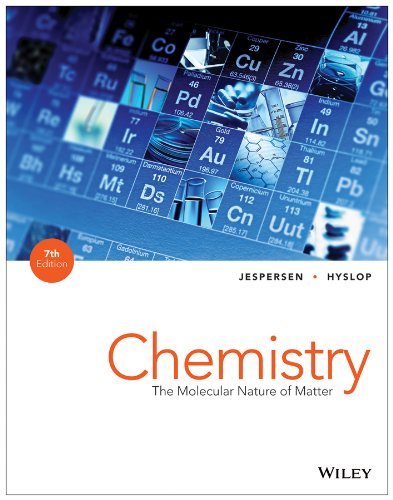This is completed downloadable of Chemistry The Molecular Nature of Matter Jespersen 7th Edition Solutions Manual

Product Details:
- ISBN-10 : 111841392X
- ISBN-13 : 978-1118413920
- Author:
Jespersen’s Chemistry 7th Edition provides readers with the necessary practice, support, instruction and assessment that is required for learning and teaching the content of a General Chemistry course. This text provides the forum for problem solving and concept mastery of chemical phenomena that leads to proficiency and success. The Seventh Edition includes revisions to key content coverage areas and concepts and the addition of more Analyzing & Solving Multi-Concept problems and examples throughout the text. An increased emphasis has also been placed on the intimate relationship that exists between structure at the submicroscopic molecular level and the observable macroscopic properties of matter. Jespersen provides readers with a clear, concise and easy to understand General Chemistry resource.
Table of Content:
0 A Very Brief History of Chemistry 1
0.1 Chemistry’s Important Concepts 2
0.2 Supernovas and the Elements 3
0.3 Elements and the Earth 5
0.4 Dalton’s Atomic Theory 7
0.5 Internal Structure of the Atom 8
Tools for Problem Solving 20
Review Questions and Problems 21
1 Scientific Measurements 24
1.1 Laws and Theories: The Scientific Method 25
1.2 Matter and Its Classifications 27
1.3 Physical and Chemical Properties 31
1.4 Measurement of Physical and Chemical Properties 32
1.5 The Uncertainty of Measurements 41
1.6 Dimensional Analysis 45
1.7 Density and Specific Gravity 49
Tools for Problem Solving 55
Review Questions and Problems 56
2 Elements, Compounds, and the Periodic Table 63
2.1 The Periodic Table 64
2.2 Metals, Nonmetals, and Metalloids 67
2.3 Molecules and Chemical Formulas 70
2.4 Chemical Reactions and Chemical Equations 77
2.5 Ionic Compounds 80
2.6 Nomenclature of Ionic Compounds 86
2.7 Molecular Compounds 91
2.8 Nomenclature of Molecular Compounds 94
Tools for Problem Solving 99
Review Questions and Problems 100
3 The Mole and Stoichiometry 108
3.1 The Mole and Avogadro’s Number 109
3.2 The Mole, Formula Mass, and Stoichiometry 115
3.3 Chemical Formula and Percentage Composition 118
3.4 Determining Empirical and Molecular Formulas 120
3.5 Stoichiometry and Chemical Equations 129
3.6 Limiting Reactants 137
3.7 Theoretical Yield and Percentage Yield 141
Tools for Problem Solving 144
Review Questions and Problems 146
4 Molecular View of Reactions in Aqueous Solutions 155
4.1 Describing Solutions 156
4.2 Electrolytes and Nonelectrolytes 158
4.3 Equations for Ionic Reactions 160
4.4 Introducing Acids and Bases 164
4.5 Acid–Base Nomenclature 172
4.6 Double Replacement (Metathesis) Reactions 174
4.7 Molarity 184
4.8 Solution Stoichiometry 191
4.9 Titrations and Chemical Analysis 195
Tools for Problem Solving 203
Review Questions and Problems 204
5 Oxidation–Reduction Reactions 212
5.1 Oxidation–Reduction Reactions 213
5.2 Balancing Redox Equations 220
5.3 Acids as Oxidizing Agents 225
5.4 Redox Reactions of Metals 229
5.5 Molecular Oxygen as an Oxidizing Agent 233
5.6 Stoichiometry of Redox Reactions 237
Tools for Problem Solving 241
Review Questions and Problems 242
6 Energy and Chemical Change 251
6.1 Energy: The Ability to Do Work 252
6.2 Heat, Temperature, and Internal Energy 255
6.3 Measuring Heat 258
6.4 Energy of Chemical Reactions 264
6.5 Heat, Work, and the First Law of Thermodynamics 266
6.6 Heats of Reaction 270
6.7 Thermochemical Equations 275
6.8 Hess’s Law 277
6.9 Standard Heats of Reaction 283
Tools for Problem Solving 291
Review Questions and Problems 292
7 The Quantum Mechanical Atom 300
7.1 Electromagnetic Radiation 301
7.2 Line Spectra and the Rydberg Equation 309
7.3 The Bohr Theory 311
7.4 The Wave Mechanical Model 314
7.5 Quantum Numbers of Electrons in Atoms 319
7.6 Electron Spin 322
7.7 Energy Levels and Ground State Electron Configurations 324
7.8 Periodic Table and Ground State Electron Configurations 326
7.9 Atomic Orbitals: Shapes and Orientations 332
7.10 Periodic Table and Properties of the Elements 336
Tools for Problem Solving 346
Review Questions and Problems 346
8 The Basics of Chemical Bonding 352
8.1 Energy Requirements for Bond Formation 353
8.2 Ionic Bonding 354
8.3 Octet Rule and Electron Configurations of Ions 358
8.4 Lewis Symbols: Keeping Track of Valence Electrons 362
8.5 Covalent Bonds 364
8.6 Bond Polarity and Electronegativity 368
8.7 Lewis Structures 373
8.8 Resonance Structures 384
8.9 Covalent Compounds of Carbon 387
Tools for Problem Solving 395
Review Questions and Problems 396
9 Theories of Bonding and Structure 403
9.1 Five Basic Molecular Geometries 404
9.2 Molecular Shapes and the VSEPR Model 407
9.3 Molecular Structure and Dipole Moments 415
9.4 Valence Bond Theory 420
9.5 Hybrid Orbitals and Molecular Geometry 423
9.6 Hybrid Orbitals and Multiple Bonds 434
9.7 Molecular Orbital Theory Basics 440
9.8 Delocalized Molecular Orbitals 447
9.9 Bonding in Solids 448
9.10 Bonding of the Allotropes of the Elements 450
Tools for Problem Solving 456
Review Questions and Problems 458
10 Properties of Gases 465
10.1. A Molecular Look at Gases 466
10.2. Measurement of Pressure 467
10.3. Gas Laws 472
10.4. Stoichiometry Using Gas Volumes 478
10.5. Ideal Gas Law 482
10.6. Dalton’s Law of Partial Pressures 490
10.7. Kinetic Molecular Theory of Gases 501
10.8. Real Gases 504
Tools for Problem Solving 507
Review Questions and Problems 508
11 Intermolecular Attractions and the Properties of Liquids and Solids 515
11.1 Intermolecular Forces 516
11.2 Intermolecular Forces and Physical Properties 525
11.3 Changes of State and Dynamic Equilibria 531
11.4 Vapor Pressures of Liquids and Solids 533
11.5 Boiling Points of Liquids 535
11.6 Energy and Changes of State 537
11.7 Phase Diagrams 541
11.8 Le Châtelier’s Principle and Changes of State 546
11.9 Determining Heats of Vaporization 547
11.10 Structures of Crystalline Solids 549
11.11 Determining the Structure of Solids 557
11.12 Crystal Types and Physical Properties 560
Tools for Problem Solving 565
Review Questions and Problems 566
12 Mixtures at the Molecular Level: Properties of Solutions 575
12.1. Intermolecular Forces and the Formation of Solutions 576
12.2. Heats of Solution 580
12.3. Solubility as a Function of Temperature 584
12.4. Henry’s Law 586
12.5. Concentration Units 588
12.6. Colligative Properties 595
12.7. Heterogeneous Mixtures 614
Tools for Problem Solving 618
Review Questions and Problems 619
13 Chemical Kinetics 625
13.1 Factors that Affect the Rate of Chemical Change 626
13.2 Measuring Reaction Rates 628
13.3 Rate Laws 634
13.4 Integrated Rate Laws 643
13.5 Molecular Basis of Collision Theory 654
13.6 Molecular Basis of Transition State Theory 657
13.7 Activation Energies 660
13.8 Mechanisms of Reactions 665
13.9 Catalysts 671
Tools for Problem Solving 675
Review Questions and Problems 676
14 Chemical Equilibrium 686
14.1 Dynamic Equilibrium in Chemical Systems 687
14.2 Equilibrium Laws 690
14.3 Equilibrium Laws Based on Pressures or Concentrations 694
14.4 Equilibrium Laws for Heterogeneous Reactions 698
14.5 Position of Equilibrium and the Equilibrium Constant 699
14.6 Equilibrium and Le Châtelier’s Principle 701
14.7 Calculating Equilibrium Constants 706
14.8 Using Equilibrium Constants to Calculate Concentrations 709
Tools for Problem Solving 722
Review Questions and Problems 724
15 Acids and Bases, A Molecular Look 731
15.1. Brønsted–Lowry Acids and Bases 732
15.2. Strengths of Brønsted–Lowry Acids and Bases 737
15.3. Periodic Trends in the Strengths of Acids 741
15.4. Lewis Acids and Bases 746
15.5. Acid–Base Properties of Elements and Their Oxides 750
15.6. Advanced Ceramics and Acid–Base Chemistry 753
Tools for Problem Solving 757
Review Questions and Problems 758
16 Acid–Base Equilibria in Aqueous Solutions 762
16.1 Water, pH, and “p” Notation 763
16.2 pH of Strong Acid and Base Solutions 767
16.3 Ionization Constants, Ka and Kb 769
16.4 Determining Ka and Kb Values 773
16.5 pH of Weak Acid and Weak Base Solutions 776
16.6 Acid–Base Properties of Salt Solutions 781
16.7 Buffer Solutions 785
16.8 Polyprotic Acids 792
16.9 Acid–Base Titrations 798
Tools for Problem Solving 807
Review Questions and Problems 808
17 Solubility and Simultaneous Equilibria 816
17.1 Equilibria in Solutions of Slightly Soluble Salts 817
17.2 Solubility of Basic Salts Is Influenced by Acids 828
17.3 Equilibria in Solutions of Metal Oxides and Sulfides 831
17.4 Selective Precipitation 834
17.5 Equilibria Involving Complex Ions 841
17.6 Complexation and Solubility 845
Tools for Problem Solving 848
Review Questions and Problems 848
18 Thermodynamics 855
18.1 First Law of Thermodynamics 856
18.2 Spontaneous Change 860
18.3 Entropy 862
18.4 Second Law of Thermodynamics 867
18.5 Third Law of Thermodynamics 871
18.6 Standard Free Energy Change, ΔG ° 874
18.7 Maximum Work and ΔG 876
18.8 Free Energy and Equilibrium 880
18.9 Equilibrium Constants and ΔG ° 886
18.10 Bond Energies 890
Tools for Problem Solving 894
Review Questions and Problems 895
19 Electrochemistry 904
19.1 Galvanic (Voltaic) Cells 905
19.2 Cell Potentials 910
19.3 Utilizing Standard Reduction Potentials 917
19.4 E °cell and ΔG ° 923
19.5 Cell Potentials and Concentrations 926
19.6 Electricity 932
19.7 Electrolytic Cells 939
19.8 Electrolysis Stoichiometry 945
19.9 Practical Applications of Electrolysis 949
Tools for Problem Solving 954
Review Questions and Problems 954
20 Nuclear Reactions and Their Role in Chemistry 962
20.1 Conservation of Mass and Energy 963
20.2 Nuclear Binding Energy 965
20.3 Radioactivity 967
20.4 Band of Stability 973
20.5 Transmutation 977
20.6 Measuring Radioactivity 980
20.7 Medical and Analytical Applications of Radionuclides 984
20.8 Nuclear Fission and Fusion 986
Tools for Problem Solving 995
Review Questions and Problems 995
21 Metal Complexes 1002
21.1 Complex Ions 1003
21.2 Metal Complex Nomenclature 1009
21.3 Coordination Number and Structure 1011
21.4 Isomers of Metal Complexes 1013
21.5 Bonding in Metal Complexes 1017
21.6 Biological Functions of Metal Ions 1024
Tools for Problem Solving 1027
Review Questions and Problems 1028
22 Organic Compounds, Polymers, and Biochemicals 1033
22.1 Organic Structures and Functional Groups 1034
22.2 Hydrocarbons: Structure, Nomenclature and Reactions 1039
22.3 Organic Compounds Containing Oxygen 1046
22.4 Organic Derivatives of Ammonia 1054
22.5 Organic Polymers 1056
22.6 Carbohydrates, Lipids, and Proteins 1063
22.7 Nucleic Acids, DNA, and RNA 1072
Tools for Problem Solving 1077
Review Questions and Problems 1079
Appendices
Appendix A: Review of Mathematics A-1
Appendix B: Answers to Practice Exercises and Selected Review Problems A-5
Appendix C: Tables of Selected Data A-28
Glossary G-1
Index I-1
People Also Search:
chemistry the molecular nature of matter jespersen 7th edition
chemistry the molecular nature of matter jespersen
chemistry the molecular nature of matter jespersen 7th edition download scribd
chemistry the molecular nature of matter jespersen 7th edition solution manual download pdf





